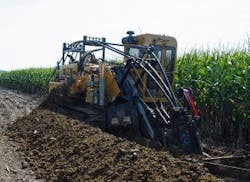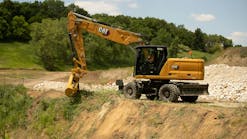Mike Anderson, Senior Editor
With the increased emphasis on wind energy, there’s work to be done for underground transmission-line installation contractors. And, as always, there’s no time to waste, even if some of the details need to be figured out along the way.
“What a majority of them are looking for is, ‘How can they do it with one machine?’ ” says Tony Bokhoven, solutions specialist with Vermeer Corporation, “and that’s what led us to the CL80."
The Vermeer CL80 cable layer attachment singularly sorts, configures and feeds three cables – one ground wire, one conduit with fiber-optic cable and one tracer tape – placing and securing the cables all in one pass. This eliminates the need for one machine to dig a trench and then another to lay and secure the cable. “There’s about a mile of ditch that comes along with every wind tower,” says Bokhoven. “With some of these wind farms, there’s some considerable trenching that goes on, and so it’s about the time. That’s the driver for why you need an attachment like this.”
At the EcoGrove Wind Farm in Stephenson County, Illinois, a crew from Morse Electric Company working a Vermeer T655 Commander 3 trencher equipped with the CL80 was able to complete the trenching and cable installation phase for a 67-tower development in 57 days, advancing about 30 feet per minute, Vermeer reports. Construction of the turbines happened simultaneously on the jobsite.
“We’re seeing a lot of activity going on in northern Iowa, northern Indiana, southern Wisconsin, and some in the Dakotas – all through that general central region of the States really – and the biggest hurdle is getting the product in the ground,” says Bokhoven. “The hurdle really is that there is no unified set of regulations on how it has to be put in the ground, so that makes it a little tough for some of the contractors. But everybody told us that they wanted the three power cables in a triangle; a majority of places do it that way.”
With the CL80, a series of rollers guides the cables over the machine and then feeds them into a cable box, where they are sorted in the appropriate configuration. On descent into the trench, the cables then begin to align in triangular formation, becoming more tightly knit on approach. The ground wire, conduit and tracer tape are placed on top of the formation as specified.
“We’ve made that attachment so that we can mount it on most of our trenching machines,” says Bokhoven. “We have a sales code that’s specifically for our 655 trencher, but we’ve fitted one up for the 755. It mounts on the end of the crumber shoe, so it mounts at a place where we can be versatile on how it goes on the tractor. The trick is keeping that chute as narrow as possible. It’s about 13 inches wide, outside to outside, and that’s about the size of the ditch that everyone wants. They don’t want to get much wider than that, because it simply takes longer to fill it in.
“The trick has become, ‘What do you fill the ditch in with?’” he says, “and that’s where the inconsistency comes in: Some places we’re seeing that they backfill with dirt; some places backfill with slurry; some places backfill with a mixture of sand and pea gravel; it’s kind of all over the board.”
The CL80 cable layer attachment is among a series of products offered by Vermeer that can meet the needs of wind-energy installation contractors. Mid-size horizontal directional drilling units meet the challenges of crossing rivers and other environmentally-sensitive areas. For use with the T655 Commander 3 tractor, the bucket-wheel attachment is suited for cross-country lines in soft soils.
“Vermeer has worked closely with the wind-energy industry, listening to their needs,” says Mark Cooper, director of specialty excavation, “and we’ve created solutions to help ease the installation of transmission lines. Contractors who own a track trencher may find the wind-energy market as another opportunity for increased utilization of their equipment just by adding other attachments.”





